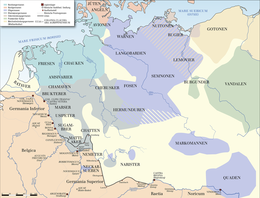Semnones
The Semnones (Latin: Semnones , Greek: οι Σέμνωνες, Σέμνονες) were, according to Tacitus ( Germania , 39), the tribal people of the Elbe-Germanic Suebi ("vetustissimi Sueborum").
Tribal history

At 6 BC The Semnones joined the Marcomanni under Marbod . In the year 5 AD Tiberius defeated the Longobards on the Lower Elbe in the course of the Immensum Bellum . Presumably he was supported by a Roman fleet. He then moved further up the Elbe and reached the Semnones on the middle Elbe and finally the Hermundurs , where he set up camp and possibly received Germanic ambassadors. The campaign participant Velleius Paterculus described the situation at that time as follows: "Nothing remained in Germania that could have been defeated, except the tribe of the Marcomanni."
In 17 AD the Semnones and Lombards fell away from Marbod and joined the Cheruscan League . Around 100 AD their settlement area was in the area between the Elbe and Oder from the Bohemian border to the Havel , and at times also beyond the Oder and Warthe . In contrast to most West Germanic tribes, the Semnones already had kings at this time. According to Tacitus, they had 100 Gaue , a statement that Gaius Iulius Caesar had made about 150 years earlier about the Suebi as a whole tribe. In their "holy grove" , the cultic center of the Suebi, human sacrifices were therefore made. Tacitus wrote about the Semnones and their place of worship:
“Vetustissimos se nobilissimosque Sueborum Semnones memorant; fides antiquitatis religione firmatur. Stato tempore in silvam auguriis patrum et prisca formidine sacram omnes eiusdem sanguinis populi legationibus coeunt caesoque publice homine celebrant barbari ritus horrenda primordia. Est et alia luco reverentia: nemo nisi vinculo ligatus ingreditur, ut minor et potestatem numinis prae se ferens. Si forte prolapsus est, attolli et insurgere haud licitum: per humum evolvuntur. Eoque omnis superstitio respicit, tamquam inde initia gentis, ibi regnator omnium deus, cetera subiecta atque parentia. Adicit auctoritatem fortuna Semnonum: centum pagi iis habitantur magnoque corpore efficitur ut se Sueborum caput credant. "
“The Semnones consider themselves the oldest and most distinguished Suebs. Belief in their old age is confirmed by a religious custom. At a certain time all the tribes of the same blood, represented by emissaries, meet in a grove which is sanctified by the omens seen by the fathers and by ancient awe. There they initiate the horrific celebration of their raw custom with public human sacrifice. The grove is also worshiped in other ways: no one enters it unless tied up to show submission and the power of the godhead. If someone falls down, he must not allow himself to be picked up or stand up himself; on the ground he rolls out. Overall, the cult is based on the belief that the tribe is derived from there, that the all-ruling God lives there, to whom everything is subject, is obedient. The wealth of the Semnones increases their reputation: they inhabit a hundred districts, and the size of their tribe causes them to consider themselves the main tribe of the Suebi. "
From the third century onwards, the Semnones left their home on the Havel and Spree in the direction of the Upper Rhine , with the exception of residual groups, and were absorbed by the Alamanni . The Semnones are mentioned for the last time in AD 260 in an inscription on the Augsburg victory altar found in 1992 as a synonym for Juthungen , an Alemannic sub-tribe. At that time, a large part of the Semnones had already migrated to southwest Germany.
literature
- Helmut Castritius , Alexander Sitzmann : Semnonen. In: Reallexikon der Germanischen Altertumskunde (RGA). 2nd Edition. Volume 28, Walter de Gruyter, Berlin / New York 2005, ISBN 3-11-018207-6 , pp. 152–158. ( online: Semnonen. §1 onomatology. pp. 152–154. )
- Dieter Geuenich : History of the Alemanni . Verlag Kohlhammer, Stuttgart 1997, ISBN 3170120956 .
- Bruno Krüger (ed.): The Germanic peoples: From the beginnings to the 2nd century of our era . In: Die Germanen: History and culture of the Germanic tribes in Central Europe: A manual in two volumes Volume 1. Akademie-Verlag, Berlin 1983.
- Rudolf Much : The Germania of Tacitus . 3rd edition, Wolfgang Lange (Ed.) With the collaboration of Herbert Jankuhn, Verlag C. Winter, Heidelberg 1967.
- Rudolf Much: German headquarters. A contribution to the oldest history of Germany . 1892.
- Cornelius Tacitus : Germania . Chapter 39 . Reclam, Stuttgart 2000, ISBN 3-15-009391-0 , or Anaconda Verlag , Cologne 2006, ISBN 3-938484-88-8 .
Individual evidence
- ↑ A visit by a Germanic prince described by Velleius Paterculus, Historia Romana 2,107,1–2, can be interpreted in this sense, see Klaus Tausend: Inside Germaniens: Relations between the Germanic tribes from the 1st century BC. Until the 2nd century AD Stuttgart 2009, p. 23.
- ^ Velleius Paterculus , Historia Romana II , cap. 106-108.
- ↑ Tacitus , Annales II
- ↑ Caesar, De Bello Gallico IV, chap. 1
